
![]()
~ THE BUFFS ~
THE CANTERBURY BARRACKS
3RD EAST KENT REGIMENT

INFANTRY BARRACKS
ARTILLERY BARRACKS
1967 - Demolition of the Former Wemyss and Infantry Barracks, Sturry Road

Map of 1843, showing the Infantry Barracks, Artillery Barracks and Cavalry Barracks and the Military Hospital
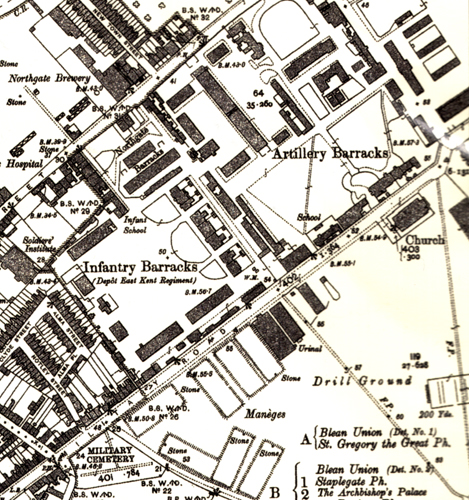
Showing the Infantry Barracks, Artillery Barracks, Drill Ground, Military Cemetery, Northgate Barracks, Soldiers Institute, Military Church & Hospital - 1907 Ordanance map detail

1912 - 9th Lancers, showing the Military Hospital and the Cathedral in the background
* In about 1793 William Baldock of Petham, builder bought the estate
known as St Gregory's priory from Stephen Bradley and Henry Irons for
£1175. By September 1804 he had built barracks and other extensive
buildings called St Gregory's Barracks on the site comprising 5 acres
1 rod 16 perches, which he had enclosed with a brick wall, and which
for several years had been occupied by HM troops. Just before he died
in December 1812 he sold the barracks to HM Commissioners for the Affairs
of Barracks for £25,500. He left his estate in the hands of trustees,
Richard Knatchbull and Nicholas Roundell Toke for the use of his nephew
William Henry Baldock. In 1817, under the Barracks Act, the barracks
were vested in the Comptroller of the Barracks department, and in 1820,
under the Ordnance Act, in the Principal Officers of the Ordnance *
After the closure of the barracks the land was sold off in lots for
house building and several new streets were laid out including Artillery
Gardens, and Artillery Street in 1831. CCA-C
C-P/E/CP/12
Entrance to the Barracks "Changing Guard The Carabiniers"
"Donated by Moira Boyle whose grandfather is seen here on parade 1913"
9th Queens Regiment Lancers Guard (1-6-12), a postcard photo in my collection by J. POWELL, Photographer, Notley Street, Canterbury, showing the same entrance to the Barracks as the photo prior
"Since the commencement of the present war, there have been erected for the military several ranges of barracks in and near the city. Near the northern suburbs, on the Margate road, opposite Barton Mill, there were erected in 1794 the royal cavalry barracks, for a complete regiment, on land purchased of Sir Edward Hales, by the board of ordnance. The are substantially built of brick, elegant and spacious, forming three sides of a quadrangle, and are said to have cost about 40,000l. The barracks for the infantry are private property, and were built in 1798 and 1799, by Messrs. Baldock and Delasaux, to contain near 2000 men. The situation of both is pleasant and healthy, the soil being dry, though well supplied with excellent water.
There are besides these, temporary barracks in different parts of the city, for detachments of the royal artillery, for two regiments of cavalry, and a proportionate number of infantry. The southern district comprizes Kent, Sussex, and Surrey. The depository for the cannon, ammunition, and ordnance stores of the royal artillery, is in a field adjoining the old Dover road, at the corner of Nackington-lane." HT

The Buffs training....unknown Barracks
1795
The Canterbury Barracks were finished, and on the 1st of October, the New Romney Light Dragoons, commanded by Colonel C. DERING, marched in as the first occupiers. They were began on the 6th May, 1794, and enclosed sixteen acres.
January 1801
Promotions - Barracks. John WILSON, late barrack master of the temporary cavalry barracks at Canterbury, to be barrack master of the permanent cavalry barracks at Canterbury. James Amyatt CHAUNDY to be barrack master of the temporary cavalry barracks at Canterbury, vice Wilson. TNAR1801
James Amyatt CHAUNDY, esq. captain on half-pay of Waller's late corps, from the temporary barracks at Canterbury. Promotions May 3, 1801 TNAR

Unknown Barracks, possibly Canterbury?
"The Barracks. The chief part of this extensive and commodious range of buildings was erected rather more than sixty years since; additions however have since been constantly made. The Cavalry Barracks at their erection alone cost £40,000; and there are proportionate Barracks for Artillery and Infantry as well, erected at a relative cost. Within the last two years extensive earthworks for target and ball practice and siege operations have been thrown up in the Exercise Field abutting the Military-road.
A new Military Church (or Chapel-School) was erected in 1855, in the Exercise Field behind the Cavalry Barracks. It is a handsome and commodious building, of Kentish rag-stone and Caen stone.
The Militia Store and Guard Room is erected near the Vauxhall turnpike-gate on the Ramsgate road, contiguous to the Cavalry Barracks. It is a substantial building, recently completed, at a cost exceeding £10,000, levied on the county and city." FS1843

The Buffs men in training....unknown Barracks (Canterbury?)
"On the road leading into the Isle of Thanet are extensive Barracks for cavalry, artillery, and infantry of the line. The cavalry barracks, erected in 1794, at an expense of £40,000, are a handsome range of brick buildings, occupying three sides of a quadrangle, and, with the several parades and grounds for exercise, comprise sixteen acres, inclosed with lofty iron palisades; the barracks for 2000 infantry, erected near the former, in 1798, have been since made a permanent station for detachments of the royal horse and foot artillery. The barracks erected on the site of St. Gregory's Priory, and in other parts of the city, have been taken down, and new streets of small houses occupy their places. " 1848

The Buffs men in training....unknown Barracks (Canterbury?)
"Canterbury is a considerable military station. The Royal Cavalry Barracks, on the Margate-road, is a fine brick building, forming three sides of a square; they were built in 1794. The Old Infantry Barracks, for 2,000 men, are also on the Margate Road, and were built in 1798. They form a station for the horse and foot officers, 1,841 non-commissioned officers and privates, and 481 horses. Here are the head-quarters of the East Kent Militia. A new Militia Barracks is now in course of erection. The Military Infirmary on the Margate-road, behind the barracks, is a handsome edifice, and an ornament to the neighbourhood."
"East Kent Militia Office and Stores, Lamb's Lane - Simon Jackson, Captain and Adjutant; Robert Jones, Quarter Master." 1858 D
1847
"Regimental Orders, by Lieut.-Colonel PINNIKUCK, Canterbury Barracks, September 20th, 1847"
Agreeably to a Route received this day from Horse Guards, the Regiment will parade in heavy marching order, at eight o'clock, A.M., on Tuesday, next, the 24th instant, for the purpose of proceeding to Dover, there to be stationed till further orders. The men will breakfast at 7 o'clock on that day.
By Order, Signed, Lieut. CODD, Acting Adjutant 17th Regiment"
"Form fours, right, quick march;" when the whole stepped off, the band at the same time striking up, "Auld Lang Syne;" marched out of barracks, down north gate, and up High Street, accompanied by such a crowd of citizens, that it is easier to imagine than describe. After marching through the principal streets, the music changed to "The Girl I left behind me" of the latter there were quite a few followed us outside of town.....

Men training....unknown Barracks (Canterbury?)
1859
Christening Canterbury Cathedral, May 31, 1859, William Henry De COUREY, son of William John & Louise DE COUREY CHADS, of Canterbury Barracks, Major in the 64th Regiment Foot
1861 (Cavalry Artillery and Northgate Barracks)
J. Dunn, Sergeant with wife G. Dunn and daughter E. Dunn (born Canterbury)
"5th Lancers - Act. Vet. Surg. Edward Stanley to be vet. surg., vice William C. Lord, transferred to the Cavalry Depot, Canterbury - 24th June, 1862."
The United Service Magazine 1863 (Promotions and Appointments)
1869
Christening Canterbury Cathedral, December 4, 1869, Amy, daughter of George & Eleanor LONGMAN, of Canterbury Barracks, Veterinary Surgeon
November 1870
War Office. November 16, 1870.
Sir, I am directed by the Secretary of State for War to acquaint you, for the information of the Lords Commissioners of Her Majesty's Treasury, that in consequence of the deficiency of the existing stable accomodation at Canterbury barracks, it has become absolutely necessary to erect temporary stables for 65 horses. The expense of carrying out the works is estimated at 1,540 l., and I am to request the sanction of their Lordships to charge it to Vote 13, Part I., on the understanding that savings to a corresponding amount will be effected on the Vote generally...... for the information of Mr. Secretary Cardwell, that they sanction the temporary appropriation as proposed therein of the sum of 1,540 l. out of savings to be effected on Vote 13, for the purpose of errecting temporary stables at Canterbury Barracks. I am, &c. J. Stansfield
1871
The Sewage from Canterbury Barracks has again proved poisonous to the trout in the upper part of the river.
"The royal cavalry barracks were built in 1794, form three sides of a square, and present a striking appearance. The old infantry barracks were built in 1798, with accommodation for 2,000 men; formed, for some time, a station for the horse and foot artillery; and are now to be used for depots of cavalry. The new infantry barracks were built in 1811."
The Imperial Gazetteer of England and Wales, Vol. I. 1872
"Canterbury is a considerable military station, being the head quarters of the depots of all the cavalry regiments on foreign service and of the Buffs (East Kent Regiment): the Royal Cavalry Barracks, on the Margate road, are fine brick buildings, forming three sides of a square and were built in 1794. The Old Infantry Barracks, sufficient for 2,000 men, are also on the Margate Road and were built in 1798; and besides these are barracks for horse and foot artillery. The New Barracks, built in 1811, provide accommodation for 99 officers, 1841 non-commissioned officers and privates and 481 horses. Here are also the head-quarters of the East Kent Militia. The Military Hospital, behind the barracks, is a plain edifice of red brick with stone dressings."
1882 directory
"About half-past eleven forty men belonging to the Cavalry Depot Brigade, under the command of Quartermaster Woods, and forty of the Royal Horse Artillery, marched into the precincts and rendered excellent service, both in assisting the local police to control the crowd and on the roof of the building."
From the Illustrated London News September 14, 1872 - Fire in the Cathedral
Stations of the British Army (corrected up to 26th December, 1867, inclusive) (Where two places are mentioned, the last-named is that at which the Depot is stationed)
4th Hussars - Bombay: Canterbury
5th Lancers - Bengal: Canterbury
7th Hussars - Bengal: Canterbury
11th Hussars - Bombay: Canterbury
13th Hussars - Canada: Canterbury
18th Hussars - Madras: Canterbury
The United Service Magazine 1868
The Buffs, Sentry's (a photograph from my collection) c. 1895?

The sign known as the Duties Board reads as
follows:
THE BUFFS (in a curve)
C oy Taking Armes A (as in A company is to furnish the armed guard)
C oy on Fire Picquet H (as in H company to furnish the daily 'first
response' fire picquet - note the spelling that was used)
C oy on Duty Bugler G (as in G company to furnish - this is hard to
read but the most likely nomination, as a Quarter Guard always included
a bugler)
Address of Medical Officer (his location was chalked on so that he could
be called to the guard room in cases of emergency)
Note: until 1915 there were 8 companies, A to H.
"courtesy of a member of the Victorian
Wars Forum"
http://www.victorianwars.com/

The sign reads "QUARTER GUARD THE BUFFS"
"solved courtesy of a member of the
Victorian Wars Forum"
http://www.victorianwars.com/
1889
1st EAST KENT REGIMENT OF VOLUNTEERS, THE BUFFS - B & C Companies
Armoury Office, Butchery Lane.
Captain Commanding B Company, Captain Hilton
Captain Commanding C Company, Captain G. H. Frend
Drill Instructor, Henry Court
plus 150 Volunteers
CANTERBURY GARRISON
Commandant, Col. Russell, 12th Lancers
Adjutant, Capt. H.M. Ridley, 7th Hussars
1st Dragoon Guards, Capt. Willett, Lieut. Eastwood
2nd Dragoon Guards, Capt. Douglas, Lieut. Cordeaux, Lieut. Gordon
3rd Dragoon Guards, Major McClellan, Lieut. Anderson
5th Lancers, Capt. Munday and Lieut. Parker
6th Dragoons, Capt. Page-Henderson, and Lieut. A. Brack-Boyd-Wilson
7th Hussars, Major Thompson, and Lieut. Nicholson
7th Dragoon Guards, Major Rough, Capt. Palmer, Lieut. Mackenzie
8th Hussars, Capt. Mitford, Capt. Duff, Lieut. Wolfe
17th Lancers, Capt. Steele, Lieut. Portal, Lieut. Tilney, Lieut. Egerton
21st Hussars, Capt Higgs, Lieut. Ewing
Riding Establishment, Col. the Hon. W.J. Stewart and Major Jones
Quarter-Master, Lieut. Naylor
James Naylor, Sergt.-Major Gymnastic Staff - 24 Havelock Street
1901
2,902 persons in the Cavalry and Remount Depot, 195 in the Infantry Barracks, and 151 in the Military Hospital
BARRACK MASTER
January 13th - Barracks. John Wilson, late barrack-master of the temporary cavalry barracks at Canterbury, to be barrack master of the permanent cavalry barracks at Canterbury. James Am. Chaundy, to be barrack master of the temporary cavalry barracks at Canterbury, vice Wilson.
The New Annual Register 1801
May 2. To be barrack master in Great Britain; John Kinsey, esq. late lieutenant colonel of the 10th light dragoons; James Amyatt Chaundy, esq. captain on half-pay of Waller's late corps, from the temporary barracks at Canterbury.
The New Annual Register 1801
Died at Canterbury, Capt. Beale, barrack-master. - The Monthly Magazine 1813 pg. 182
"Marriage, At the Old Church, Edgbaston, Birmingham, Capt. John Yates, Adjutant Cavalry Depot, Canterbury, to Frances Margaret, only dau. of George Yates, esq., of Edgbaston. Feb 10, 1860."
Gentlemen's Magazine 1860
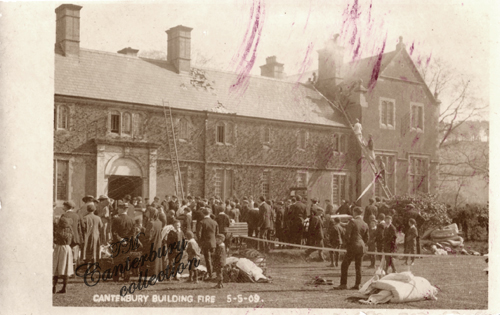
Canterbury Married Quarter Barracks, a postcard photo in my collection
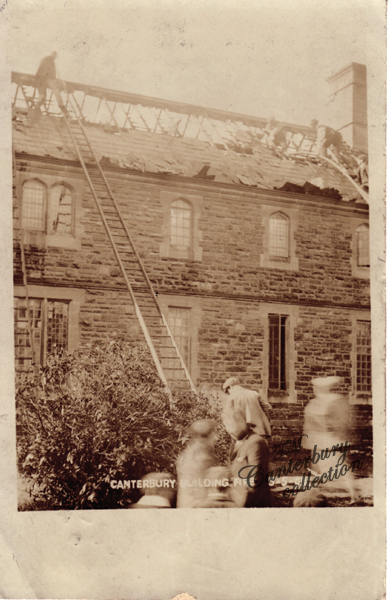
Canterbury building fire 5-5-09
1891
Annual Register 1892, page 65
November 16, 1891 A fire at the Cavalry Barracks at Canterbury destroyed an extensive range of buildings, occupied as stables and married mens quarters. There was an almost complete absence of water, so that the progress of the flames was unchecked. The damage done was estimated at about 9,000l.
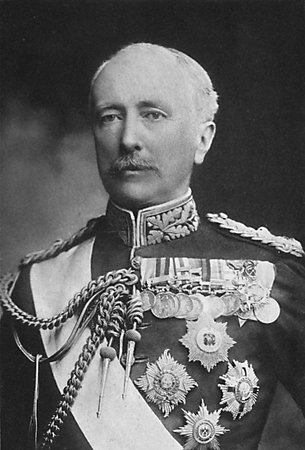
Field-Marshal Viscount Wolseley (P.D.)
"The new Commander-in-chief (Lord Wolseley) visited the Cavalry Depot, Canterbury, on the 16th inst. (Jan), and made a thorough inspection of the men, rooms, etc., and on his departure conveyed to Colonel H. R. Abadie, C.B., an expression of his entire satisfaction with the whole inspection."
The Kentish Gazette & Canterbury Press, Saturday, December 26, 1896 (January happenings)
The Barracks c. 1899
The Barracks for the infantry adjoins Jesus Hospital, they are extensive and commodious, and are capable of accommodating 2,000 men; they were erected in 1798. The Barracks for the Cavalry, adjoining, are an extensive range of buildings.

Infantry Barracks
The several barrack squares with their well kept gravel walks and parade grounds planted with trees, have a picturesque appearance.
The Military Church
This building stands in a field at the back of the Cavalry Barracks. It was erected in 1855.
The Military Infirmary
In 1811 this spacious building was erected on a eminence at the back of the barracks as a general infirmary for the various regiments. It is a substantial structure, and stands on one of the most beautiful and salubrious spots that could be selected for the purpose.
Canterbury Barracks - 7th Dragoon Guards, Prensentation of Standard. Princess Royal, 1906, a postcard photo in my collection
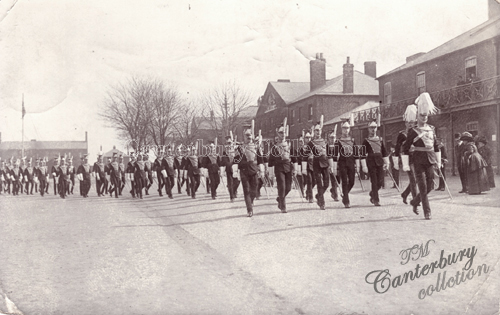
Mailed from Canterbury September 14, 1910, possibly also showing the Barracks (as it looks like the building above on the left)
The Barracks
The chief part of this extensive and commodious range of buildings was erected rather more than sixty years since; additions however have since been constantly made. The Cavalry Barracks at their erection alone cost £40,000; and there are proportionate Barracks for Artillery and Infantry as well, erected at a relative cost. Within the last two years extensive earthworks for target and ball practice and siege operations have been thrown up in the Exercise Field abutting the Military Road.
A new Military Church (or Chapel School) was erected in 1855, in the Exercise Field behind the Cavalry Barracks. It is a handsome commodious building, of Kentish ragstone and Caen Stone.
The Militia Store and Guard Room is erected near the Vauxhall turnpike gate on the Ramsgate Road, contiguous to the Cavalry Barracks. It is a substantial building, recently completed at a cost exceeding £10,000, levied on the county and city. COT1860

Army Canteena "Civilians Cannot be Served Civilian Persons are not allowed in this canteen..."
1905 Canterbury Barracks. Barrack atlas plans of the Artillery and Infantry Barracks. WO78/3259 + exercising ground and married quarters WO78/3260

St. Alban's Old Garrison Church c. 1840, now called All Saints, Canterbury
You might even be lucky to find information on one of your ancestors:
Used to be a Military Cemetery in Canterbury, was changed into a playground in the 1970's:
George BAKER born Canterbury, served in the 4th Dragoons; 54th Foot Regiment WO97/15 (dates covered 1808-1820)
Richard ATTWOOD born Canterbury, served in the 15th Dragoons (light) WO97/14 (dates covered 1827-53)
John AUSTIN born in Canterbury, served in the 15th Dragoons (light) WO97/14 (dates covered 1831-1839)
William PHILPOT born in Canterbury served in the 3rd Dragoon Guards, discharged age 45 W)97/108 (dates covered 1812-1843)
George WEEKS born in Canterbury, Kent, served in the 15th Dragoons (light) discharged age 28 WO97/141 (dates covered 1843-1854)
John WICKENDEN born in Canterbury served in the 35th Foot Regiment, 57th Foot Regiment, discharged age 32 WO97/528 (dates covered 1813-24)
Joseph OVENDEN born in Canterbury, Kent, served in the 46th foot regiment, discharged age 39 WO97/608 (dates covered 1819-1842)
Isaac WILDISH born Canterbury, Kent, served in Rifle Brigade, discharged age 22 W097/1090 (dates covered 1835-1839)
William BLIGH, born Canterbury, Kent, served in the Royal Waggon Train, discharged age 42 WO97/1153 (dates covered 1801-1826)
Motto "Veteri Frondescit Honore"....."With its Ancient Honour it is Evergreen"
© T. Machado 2007

